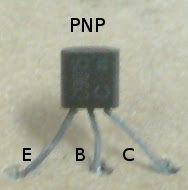Determine terminals and type of transistor using analog multimeter
Almost all of analogue multimeter or AVO meter (Ampere, Volt and Ohm meter, as shown in the figure below), can use to determine terminals (base, emitter, and collector) and type of transistor (PNP or NPN). On this configuration, turn the knob multimeter's position on Ohm meter test or at symbol Ω.

We take an example to be measured is transistor BJT type FCS9015, which is quite widely use. We learned to determine terminals and type of transistor FCS9015, and the following steps:
1. Measuring and create tables of measurement
2. Determine base terminal and type of transistor
On the measurements table, there are two measurement points that get results, that is point 1-2 and point 3-2 (see figure above). It is time for us to determine the terminals and type of transistor, by the way:
3. Determine emitter and collector terminals of transistor
Needle's moves at measurements points 1-2 and 3-2, almost have equal value, so it will be difficult to determine terminals collector and emitter using analogue meter. So we use a manual way, ie with visual or sight. There are several characteristics that indicate the collector's terminal, among others:
We've been able to determine base and collector of terminals transistor, then last is emitter terminal.
So we get the conclusion:
How to determine terminals base, emitter and collector of transistor using digital multimeter? just click that link.

We take an example to be measured is transistor BJT type FCS9015, which is quite widely use. We learned to determine terminals and type of transistor FCS9015, and the following steps:
1. Measuring and create tables of measurement
- Set analogue multitester and adjust position of rotary knob on Ohm meter, a measurement scale at x10
- Imagine or describe the position of terminals transistor with sequence numbers 1, 2, and 3
- Create a table with 6 units of measurement measuring point, ie 1-2, 1-3, 2-3, 2-1, 3-1, and 3-2
- Specify black probe or negative test probe for the first number, and red probe or positive test probe for the second number, ie the measuring point 1-2, the black probe at point 1, and the red probe at point 2
- Record the results of each measurements, indicated by Ohm meter's needle movement

2. Determine base terminal and type of transistor
On the measurements table, there are two measurement points that get results, that is point 1-2 and point 3-2 (see figure above). It is time for us to determine the terminals and type of transistor, by the way:
- Base is the same number found on the two measuring points
- Type NPN or type PNP, we can set it to see what probe is connected to the base. If base point connected to black probe, then NPN type transistor, and when base point connected to red probe, then PNP type transistor
There is different probe usage between analog multimeter and digital multimeter. In the analog multimeter, red probe is connected to negative battery Ohm meter, and black probe is connected to positive battery Ohm meter
3. Determine emitter and collector terminals of transistor
Needle's moves at measurements points 1-2 and 3-2, almost have equal value, so it will be difficult to determine terminals collector and emitter using analogue meter. So we use a manual way, ie with visual or sight. There are several characteristics that indicate the collector's terminal, among others:
- The letter C is printed larger
- There is a little hole
- Generally connected to the metal on packaging or transistor's body, especially at high power transistor body
We've been able to determine base and collector of terminals transistor, then last is emitter terminal.
So we get the conclusion:
- At point 2 terminal base of transistor FCS9015
- FCS9015 is a PNP transistor, the base on red probe
- At point 3 terminal collector FCS9015, see! there is letter C is printed larger
- At point 1 terminal emitter of transistor FCS9015
- Terminals and type of transistor FCS9015 as shown in the picture below

How to determine terminals base, emitter and collector of transistor using digital multimeter? just click that link.






Hi,
ReplyDeleteWow! This is a nice share. I didn't know this tricks that you shown here. Thank you for your nice sharing. Really got some good idea.